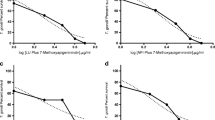Abstract
While Toxoplasma gondii is able to infect and replicate within all eukaryotic cells, tachyzoites are the infective form of T. gondii that invades all eukaryotic cells leading to tissue rupture, the main features of toxoplasmosis. The present study evaluates the activity of (benzaldehyde)-4-phenyl-3-thiosemicarbazone and (benzaldehyde)-(4 or 1)-phenylsemicarbazone against intracellular T. gondii. The nine new compounds were incubated in infected Vero cells at concentrations of 0.01, 0.1, 0.5, and 1.0 mM and evaluated for three main effects: cytotoxicity, infection, and number of intracellular parasites. The cytotoxicity test showed a pattern by analyzing the substituent arylhydrazone, where trihydroxy Compounds 4–9 were cytotoxic at concentrations of 0.5 and 1.0 mM. The results highlight Compound 8, which reduced the number of intracellular parasites by 82 % in a concentration of 0.01 mM and showed a LD50 of 0.3 mM in cell culture. These different biological actions are due to changes in the molecular structure and type of radical present in each compound. All compounds tested were more efficient than the control drug sulfadizine.


Similar content being viewed by others
References
Aquino TM, Liesen AP, Silva R, Lima V, Carvalho C, Faria A, Araújo J, Lima J, Alves AJ, Melo EJT, Góes AJS (2008) Synthesis, anti-Toxoplasma gondii and antimicrobial activities of benzaldehyde 4-phenyl-3-thiosemicarbazones and 2-[(phenylmethylene)hydrazono]-4-oxo-3-phenyl-5-thiazolidineacetic acids. Bioorg Med Chem 16:446–456
Bosch-Driessen L, Verbraak F, Suttorp-Schulten M, van Ruyven R, Klok A, Hoyng C, Rothova A (2002) A prospective, randomized trial of pyrimethamine and azithromycin vs pyrimethamine and sulfadiazine for the treatment of ocular toxoplasmosis. Am J Ophthalmol 134:34–40
Carvalho CS, Melo EJT (2006) Acidification of parasitophorus vacuole containing Toxoplasma gondii in the presence of hidroxyurea. An Acad Bras Cienc 78:475–484
Carvalho CS, Melo EJT, Tenório RP, Góes AJS (2010) Anti-parasitic action and elimination of intracellular Toxoplasma gondii in the presence of novel thiosemicarbazone and 4-thiozolidinones derivates. Braz J Med Biol Res 43:139–149
Casas JS, Garcia-Tasende M, S, Sordo J (2000) Main group metal complexes of semicarbazones and thiosemicarbazones: a structural review. Coord Chem Rev 209:197–261
Chen J, Huang Y, Liu G, Afrasiabi Z, Sinn E, Padhye S, Ma Y (2004) The cytotoxicity and mechanisms of 1,2-naphthoquinone thiosemicarbazone and its metal derivatives against mcf-7 human breast cancer cells. Toxicol Appl Pharmacol 197:40–48
Dannemann B, Israelski D, Leoung G, McGraw T, Mills J, Remington JS (1991) Toxoplasma serology, parasitemia and antigenemia in patients at risk for toxoplasmic encephalitis. AIDS 5:1363–1365
Hancock CN, Stockwin LH, Han B, Divelbiss RD, Jun JH, Malhotra SV, Hollingshead MG, Newton DL (2011) A copper chelate of thiosemicarbazone NSC 689534 induces oxidative/ER stress and inhibits tumor growth in vitro and in vivo. Free Radic Biol Med 50:110–121
Hill D, Dubey J (2002) Toxoplasma gondii: transmission, diagnosis and prevention. Clin Microbiol Infect 8:634–640
Hutchinson DW (1985) Metal chelators as potential antiviral agents. Antivir Res 5:193–205
James GS, Sintchenko VG, Dickenson DJ, Gilbert GL (1996) Comparison of cell culture, mouse inoculation, and PCR for detection of Toxoplasma gondii: effects of storage conditions on sensitivity. J Clin Microbiol 34:1572–1575
Kesel AJ (2011) Broad-spectrum antiviral activity including human immunodeficiency and hepatitis c viruses mediated by a novel retinoid thiosemicarbazone derivative. Eur J Med Chem 45:1656–1664
Kim K, Weiss L (2004) Toxoplasma gondii: the model apicomplexan. Int J Parasitol 34:423–432
Levine ND, Corliss JO, Cox FEG, Deroux G, Grain J, Honigberg BM, Leedale GF, Loeblich AR, Lom J, Lynn D, Merinpeld EG, Page FC, Poljansky G, Sprague V, Vavra J, Wallace FG (1980) A newly revised classification of the protozoa. J Protozool 27:37–58
Luft B, Remington J (1992) Toxoplasmic encephalitis in aids. Clin Infect Dis 15:211–222
Melo EJT, Beiral HJ (2003) Effect of hydroxyurea on the intracellular multiplication of Toxoplasma gondii, Leishmania amazonensis and Trypanosoma cruzi. Braz J Med Biol Res 36:65–69
Melo EJT, Souza W (2000) Effect of hydroxyurea on intracellular Toxoplasma gondii. FEMS Microbiol Lett 185:79–85
Oliveira RB, Souza-Fagundes EM, Soares RPP, Andrade AA, Krettli AU, Zani CL (2008) Synthesis and antimalarial activity of semicarbazone and thiosemicarbazone derivatives. Eur J Med Chem 43:1983–1988
Qin Y, Xing R, Liu S, Li K, Meng X, Li R, Cui J, Li B, Li P (2012) Novel thiosemicarbazone chitosan derivatives: preparation, characterization, and antifungal activity. Carbohydr Polym 87:2664–2670
Rodrigues C, Batista AA, Ellena J, Castellano EE, Benítez D, Cerecetto H, González M, Teixeira LR, Beraldo H (2010) Coordination of nitro-thiosemicarbazones to ruthenium(ii) as a strategy for anti-trypanosomal activity improvement. Eur J Med Chem 45:2847–2853
Tenório RP, Carvalho CS, Pessanha CS, Lima J, Faria A, Alves AJ, Melo EJT, Góes AJS (2005) Synthesis of thiosemicarbazone and 4-thiazolidinone derivatives and their in vitro anti-Toxoplasma gondii activity. Bioorg Med Chem Lett 15:2575–2578
Turan-Zitouni G, Kaplancikli ZA, Yildiz MT, Chevallet P, Kaya D (2002) Synthesis and in vitro antibacterial activity of new steroidal thiosemicarbazone derivatives. Eur J Med Chem 10:607–613
Wong S, Remington JS (1993) Biology of Toxoplasma gondii. AIDS 7:299–316
Acknowledgements
The authors are grateful for the support received from the Cordenação de Aperfeiçoamento de Pessoal Nível Superior (Capes), the Fundação de Amparo à à Pesquisa do Estado do Rio de Janeiro Carlos Chagas Filho (Faperj) and the english reviewer John Marr Ditty.
Author information
Authors and Affiliations
Corresponding author
Rights and permissions
About this article
Cite this article
Gomes, M.A.G.B., Carvalho, L.P., Rocha, B.S. et al. Evaluating anti-Toxoplasma gondii activity of new serie of phenylsemicarbazone and phenylthiosemicarbazones in vitro. Med Chem Res 22, 3574–3580 (2013). https://doi.org/10.1007/s00044-012-0347-9
Received:
Accepted:
Published:
Issue Date:
DOI: https://doi.org/10.1007/s00044-012-0347-9




